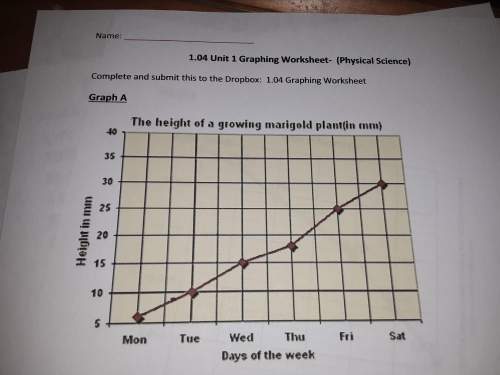
Mathematics, 26.06.2019 21:30 eddyy5900
1. what is the independent variable in this graph? 2. list the range of the dependent variable values.3. explain how to intercept the data for this graph. (what is happening to the height of q growing marigold during this week? )i need asapits physical science


Answers: 1


Other questions on the subject: Mathematics

Mathematics, 21.06.2019 18:40, rivera8
Juliana says that she can use the patterns of equivalent ratios in the multiplication table below to write an infinite number of ratios that are equivalent to 6: 10. which statement explains whether juliana is correct? she is correct because she can multiply 6 and 10 by any number to form an equivalent ratio. she is correct because 6: 10 can be written as 1: 2 and there are an infinite number of ratios for 1: 2. she is not correct because the multiplication table does not include multiples of 10. she is not correct because 6: 10 is equivalent to 3: 5 and there are only 9 ratios in the multiplication table that are equivalent to 3: 5.
Answers: 1

Mathematics, 21.06.2019 19:00, issaaamiaaa15
You got a job selling magazines door-to-door. you are paid $100 per day plus $1.50 for each magazine you sell. which recursive formula models this situation?
Answers: 1

Mathematics, 21.06.2019 23:30, bbby2
Aprisoner is trapped in a cell containing three doors. the first door leads to a tunnel that returns him to his cell after two days of travel. the second leads to a tunnel that returns him to his cell after three days of travel. the third door leads immediately to freedom. (a) assuming that the prisoner will always select doors 1, 2 and 3 with probabili- ties 0.5,0.3,0.2 (respectively), what is the expected number of days until he reaches freedom? (b) assuming that the prisoner is always equally likely to choose among those doors that he has not used, what is the expected number of days until he reaches freedom? (in this version, if the prisoner initially tries door 1, for example, then when he returns to the cell, he will now select only from doors 2 and 3.) (c) for parts (a) and (b), find the variance of the number of days until the prisoner reaches freedom. hint for part (b): define ni to be the number of additional days the prisoner spends after initially choosing door i and returning to his cell.
Answers: 1

Mathematics, 22.06.2019 03:00, cupcake3103670
Explain how to convert measurements in the metric system
Answers: 1
You know the right answer?
1. what is the independent variable in this graph? 2. list the range of the dependent variable value...
Questions in other subjects:








Mathematics, 27.06.2019 16:40


Geography, 27.06.2019 16:40



